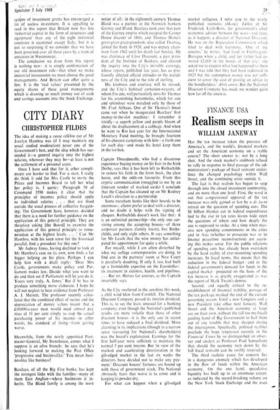Realism seeps in
FINANCE USA WILLIAM JANEWAY
Has the tax increase taken the pressure off America's, and the world's, financial markets and set the American economy on a stable course? The short answer is: not by a long shot. And the stock market's stubborn refusal to rally in response to final passage of the ad- ministration's package of fiscal restraint under- lines the changed psychology within Wall Street, and the continuing crisis outside it.
The fact is that realism has begun to seep through into the closed investment community, and on more than one level. First, the word is out that congressional approval, of the tax increase was only gained at last by a de facto retreat on the question of spending cuts. The $6 billion blanket cut in federal expenditures tied to the rise in tax rates leaves wide open the questions of where and how deeply the axe is supposed to strike. At a time when mas- sive new spending commitments in the cities and in Asia (whether to prosecute war or to finance peacetime reconstruction) are accru- ing this makes sense. For the public relations of spending cuts has already been overtaken by the hard reality of ever-mounting spending increases. In fiscal terms, this means that the reduction in the federal budget— and in the federal government's demand for funds in the capital market-- projected on the basis of the tax increase is as greatly exaggerated as was the report of Mark Twain's demise.
Second, and equally critical to the re- establishment of financial stability, passage of the tax package marked the end of the current governing season. Until a new Congress and a new President take office next January. Wall Street and the American economy at large are on their own, without the (all too mythical) guiding hand of Big Government to bail them out of any trouble that may sharpen during the interregnum. Specifically, political realities preclude the hope (expressed recently in the Financial Times by so distinguished an obser- ver and analyst as Professor Paul Samuelson) that should the economy turn down by the fall fiscal restraint can be swiftly reversed.
The third realistic cause for concern lies in a dangerous anomaly which has developed in the flow of funds within the American economy. On the one hand, - speculative liquidity has built up to an enormous cxtept, as indicated by the record-breaking volume on the New York Stock Exchange and the even more explosive activity on the American and over-the-counter markets. At the same time institutional borrowers—corporations, state and local governments and the federal government itself—are generating an unprecedented de- mand for long-term money. Partly, this is a reflection of inflationary pressures, particularly wage increases which have put an increasing premium on investment in labour saving. But, on the governmental side (and in the private sector, too, as it is harnessed to facing up to the ghetto crisis), the demand for funds is based on political and social realities which can be sharpened only by a falling off in the rate of economic expansion. In other words, beyond the confines of the federal budget, the demand for investment funds by all borrowers can only continue to rise—at the same time as short-term speculation is reaching levels unseen for more than a generation.
The result of these cross-currents is the problem which faces the one economic and financial authority which still can exercise real influence during the coming months of execu- tive impotence and congressional recess. This is the Federal Reserve Board.. Historically, there are three reasons for fearing the FRB when it holds the initiative and when outside political constraints on its actions are effectively eliminated. The first reason is its long-demon- strated bias, shared with other monetary authorities, towards 'holding the line against inflation' whatever the specifics of a particular policy problem may be. The second is its orientation towards curbing speculation at the short end of the money market with relatively little regard for conditions at the much less volatile (and, economically, far more impor- tant for growth and prosperity) long end. The third reason is the board's recent record—in 1958, 1960, 1963 and 1966—of seizing moments of presidential weakness or political upset (seeming or real) to demonstrate, actively and dramatically, its own continued existence.
Final passage of the tax increase has served one thoroughly beneficial purpose. It has cleared the air for serious consideration of the underlying crisis which continues to face the Ainerican political economy. In simple, even simplistic, terms, this crisis grows out of the pressing requirement that substantial resources ' —above all, financial resources—be directed both towards the physical rebuilding of America's cities and the far more difficult effec- tive integration of some twenty million people into American society and the American eco- nomy. The crisis has been and is being sharpened by the diversion of resources to Vietnam, a diversion which will very probably not cease if and when the shooting stops.
In any case, the exercise of the overall tools of economic management, fiscal and monetary. can only create a climate in which this crisis can be approached with greater or less chance of alleviation. The basis for alarm at the current economic climate in America is due to apprehension that the recent exercise of the fiscal tool has by no means created a stable and expansive climate for progressive change, and that the threatened exercise of the mone- tary tool by the Federal Reserve will serve further to disrupt a highly delicate situation. In the meantime, six months of non-govern- ment will have to be survived before either the climate can be altered or the crisis attacked. That the stock market seems at length to be in touch with these realities con- stittites at least one source of hope, albeit negative, in one significant area, albeit limited.











































 Previous page
Previous page